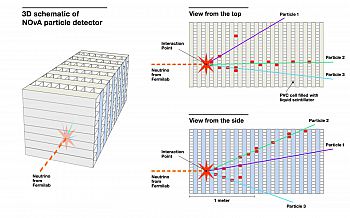Sussex physicists probe universe’s earliest moments with neutrino experiment
A major international experiment, involving University of Sussex physicists, has come closer to illuminating the universe’s earliest moments after capturing evidence of neutrino oscillations.
 A graphic representation of one of the first neutrino interactions captured at the NOvA far detector in northern Minnesota. The dotted red line represents the neutrino beam, generated at Fermilab in Illinois and sent 500 miles to the far detector.
A graphic representation of one of the first neutrino interactions captured at the NOvA far detector in northern Minnesota. The dotted red line represents the neutrino beam, generated at Fermilab in Illinois and sent 500 miles to the far detector.
The NOvA experiment uses two massive detectors in the USA, placed 500 miles apart, to detect and study mysterious particles called neutrinos.
Neutrinos are abundant in the atmosphere but they have barely any mass and very rarely interact with other matter. Many of the neutrinos around today are thought to have originated in the Big Bang – and studying them could yield crucial information about the early moments of the universe.
This week scientists announced they had seen their first evidence that the elusive particles were changing or ‘oscillating’ as they travelled in a high-energy beam from a near detector at Fermilab in Chicago to a far detector hundreds of miles away in Minnesota.
The beam that originates at Fermilab is made almost entirely of one type of neutrinos – muon neutrinos. Scientists from around the world, including a team of seven researchers from Sussex, have been measuring how many of those muon neutrinos disappear over their journey and reappear as electron neutrinos.
Neutrino oscillations have been observed previously in other experiments, but the data from NOvA’s 14,000-ton far detector should bring scientists closer to understanding the properties of these mysterious particles.
Dr Jonathan Davies, a member of the Sussex team, explains: “Neutrino oscillations are the only phenomena we’ve discovered that sit outside the Standard Model of physics. This makes them a fundamentally important phenomena for particle physics, and an exciting area for physicists to work on.”
Scientists theorise that the Big Bang created equal amounts of matter and antimatter. When corresponding particles of matter and antimatter meet, they annihilate one another. But somehow we’re still here, and antimatter, for the most part, has vanished.
Through measuring data captured by the NOvA experiment, physicists are hoping to shed light on the relative masses of neutrinos. This could pave the way to understanding why there is more matter than antimatter in the universe.
The video below shows the two year long process of constructing the experiment's far detector, the world's largest self-supporting plastic structure.
Sussex researcher Dr Matthew Tamsett worked as the coordinator for the group of international scientists who processed and produced the data needed to observe the neutrinos oscillating.
Dr Tamsett said: “The results so far offer tantalising hints of what’s to come. They’ve demonstrated that this multimillion dollar experiment really does work and is already chomping at the heels of the more established competition.
“The team from Sussex, the only UK scientists working on NOvA, have played a key part in this. We have gone from strength to strength and are now one of the biggest groups working on the experiment.”
The Sussex group working on the experiment is led by Dr Jeff Hartnell and includes Dr Jonathan Davies, Dr Matthew Tamsett, Dr Bruno Zamorano, Tristan Blackburn, Diana Méndez and Luke Vinton.

